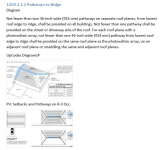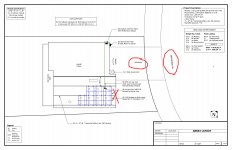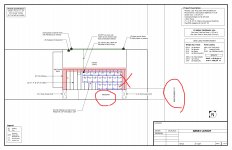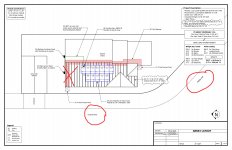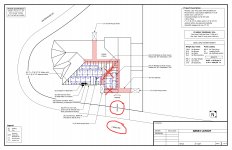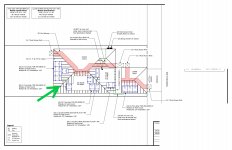You are using an out of date browser. It may not display this or other websites correctly.
You should upgrade or use an alternative browser.
You should upgrade or use an alternative browser.
fire pathways
- Thread starter Zee
- Start date
Joe.B
Senior Member
- Location
- Myrtletown Ca
- Occupation
- Building Inspector
I think you are you comparing the current 2022 CA Fire Code to the 2016 CFC, correct?
I agree they have simplified the requirements by removing mention of hips and valley's. I don't see an issue, as long as both pathways and setbacks are observed then the fire department should be able to perform the actions needed.
2022 CFC
1205.2.1.1 Pathways to Ridge
Not fewer than two 36-inch-wide (914 mm) pathways on separate roof planes, from lowest roof edge to ridge, shall be provided on all buildings. Not fewer than one pathway shall be provided on the street or driveway side of the roof. For each roof plane with a photovoltaic array, not fewer than one 36-inch-wide (914 mm) pathway from lowest roof edge to ridge shall be provided on the same roof plane as the photovoltaic array, on an adjacent roof plane or straddling the same and adjacent roof planes.
1205.2.1.2 Setbacks at Ridge
For photovoltaic arrays occupying 33 percent or less of the plan view total roof area, a setback of not less than 18 inches (457 mm) wide is required on both sides of a horizontal ridge. For photovoltaic arrays occupying more than 33 percent of the plan view total roof area, a setback of not less than 36 inches (457 mm) wide is required on both sides of a horizontal ridge.
1205.2.1.3 Alternative Setbacks at Ridge
Where an automatic sprinkler system is installed within the dwelling in accordance with Section 903.3.1.3, setbacks at the ridge shall conform to one of the following:
1. For photovoltaic arrays occupying 66 percent or less of the plan view total roof area, a setback of not less than 18 inches (457 mm) wide is required on both sides of a horizontal ridge.
2. For photovoltaic arrays occupying more than 66 percent of the plan view total roof area, a setback of not less than 36 inches (914 mm) wide is required on both sides of a horizontal ridge.
2016 CFC
605.11.1.2.1 Pathways to Ridge
A minimum of two 36-inch-wide (914 mm) pathways on separate roof planes, from lowest roof edge to ridge, shall be provided on all buildings. At least one pathway shall be provided on the street or driveway side of the roof. For each roof plane with a photovoltaic array, at least one 36-inch-wide (914 mm) pathway from lowest roof edge to ridge shall be provided on the same roof plane as the photovoltaic array, or on an adjacent roof plane, or straddling the same and adjacent roof planes.
605.11.1.2.2 Setbacks at Ridge
For photovoltaic arrays occupying 33 percent or less of the plan view total roof area, a minimum 18-inch-wide (457 mm) setback is required on both sides of a horizontal ridge. For photovoltaic arrays occupying more than 33 percent of the plan view total roof area, a minimum 36-inch-wide (914 mm) setback is required on both sides of a horizontal ridge.
605.11.1.2.2.1 Alternative Setbacks at Ridge
Where an automatic sprinkler system is installed within the dwelling in accordance with NFPA 13D, setbacks at ridge shall conform with one of the following:
For photovoltaic arrays occupying 66 percent or less of the plan view total roof area, a minimum 18-inch-wide (457 mm) setback is required on both sides of a horizontal ridge.
For photovoltaic arrays occupying more than 66 percent of the plan view total roof area, a minimum 36-inch-wide (914 mm) setback is required on both sides of a horizontal ridge.
605.11.1.2.3 Single-Ridge Roofs
Panels and modules installed on Group R-3 buildings with a single ridge shall be located in a manner that provides two, 3-foot-wide (914 mm) access pathways from the eave to the ridge on each roof slope where panels and modules are located.
Exception: This requirement shall not apply to roofs with slopes of two units vertical in 12 units horizontal (2:12) or less.
605.11.1.2.4 Roofs With Hips and Valleys
Panels and modules installed on Group R-3 buildings with roof hips and valleys shall not be located closer than 18 inches (457 mm) to a hip or a valley where panels/modules are to be placed on both sides of a hip or valley. Where panels are to be located on only one side of a hip or valley that is of equal length, the panels shall be permitted to be placed directly adjacent to the hip or valley.
Exception: These requirements shall not apply to roofs with slopes of two units vertical in 12 units horizontal (2:12) or less.
I agree they have simplified the requirements by removing mention of hips and valley's. I don't see an issue, as long as both pathways and setbacks are observed then the fire department should be able to perform the actions needed.
2022 CFC
1205.2.1.1 Pathways to Ridge
Not fewer than two 36-inch-wide (914 mm) pathways on separate roof planes, from lowest roof edge to ridge, shall be provided on all buildings. Not fewer than one pathway shall be provided on the street or driveway side of the roof. For each roof plane with a photovoltaic array, not fewer than one 36-inch-wide (914 mm) pathway from lowest roof edge to ridge shall be provided on the same roof plane as the photovoltaic array, on an adjacent roof plane or straddling the same and adjacent roof planes.
1205.2.1.2 Setbacks at Ridge
For photovoltaic arrays occupying 33 percent or less of the plan view total roof area, a setback of not less than 18 inches (457 mm) wide is required on both sides of a horizontal ridge. For photovoltaic arrays occupying more than 33 percent of the plan view total roof area, a setback of not less than 36 inches (457 mm) wide is required on both sides of a horizontal ridge.
1205.2.1.3 Alternative Setbacks at Ridge
Where an automatic sprinkler system is installed within the dwelling in accordance with Section 903.3.1.3, setbacks at the ridge shall conform to one of the following:
1. For photovoltaic arrays occupying 66 percent or less of the plan view total roof area, a setback of not less than 18 inches (457 mm) wide is required on both sides of a horizontal ridge.
2. For photovoltaic arrays occupying more than 66 percent of the plan view total roof area, a setback of not less than 36 inches (914 mm) wide is required on both sides of a horizontal ridge.
2016 CFC
605.11.1.2.1 Pathways to Ridge
A minimum of two 36-inch-wide (914 mm) pathways on separate roof planes, from lowest roof edge to ridge, shall be provided on all buildings. At least one pathway shall be provided on the street or driveway side of the roof. For each roof plane with a photovoltaic array, at least one 36-inch-wide (914 mm) pathway from lowest roof edge to ridge shall be provided on the same roof plane as the photovoltaic array, or on an adjacent roof plane, or straddling the same and adjacent roof planes.
605.11.1.2.2 Setbacks at Ridge
For photovoltaic arrays occupying 33 percent or less of the plan view total roof area, a minimum 18-inch-wide (457 mm) setback is required on both sides of a horizontal ridge. For photovoltaic arrays occupying more than 33 percent of the plan view total roof area, a minimum 36-inch-wide (914 mm) setback is required on both sides of a horizontal ridge.
605.11.1.2.2.1 Alternative Setbacks at Ridge
Where an automatic sprinkler system is installed within the dwelling in accordance with NFPA 13D, setbacks at ridge shall conform with one of the following:
For photovoltaic arrays occupying 66 percent or less of the plan view total roof area, a minimum 18-inch-wide (457 mm) setback is required on both sides of a horizontal ridge.
For photovoltaic arrays occupying more than 66 percent of the plan view total roof area, a minimum 36-inch-wide (914 mm) setback is required on both sides of a horizontal ridge.
605.11.1.2.3 Single-Ridge Roofs
Panels and modules installed on Group R-3 buildings with a single ridge shall be located in a manner that provides two, 3-foot-wide (914 mm) access pathways from the eave to the ridge on each roof slope where panels and modules are located.
Exception: This requirement shall not apply to roofs with slopes of two units vertical in 12 units horizontal (2:12) or less.
605.11.1.2.4 Roofs With Hips and Valleys
Panels and modules installed on Group R-3 buildings with roof hips and valleys shall not be located closer than 18 inches (457 mm) to a hip or a valley where panels/modules are to be placed on both sides of a hip or valley. Where panels are to be located on only one side of a hip or valley that is of equal length, the panels shall be permitted to be placed directly adjacent to the hip or valley.
Exception: These requirements shall not apply to roofs with slopes of two units vertical in 12 units horizontal (2:12) or less.
ggunn
PE (Electrical), NABCEP certified
- Location
- Austin, TX, USA
- Occupation
- Consulting Electrical Engineer - Photovoltaic Systems
Yes, the new fire code is mostly about 36" pathways to the ridges from two sides of the house, and one of them must be from the street or driveway side. It is simpler to interpret and to comply with.
BackCountry
Electrician
- Location
- Southern California
- Occupation
- Licensed Electrician and General Contractor
For residential, it seems the latest CFC does not describe pathways required at hips/valleys as clearly as the 2018 CFC.
What is your interpretation of the current rules around pathways adjacent to hips? Where are they required?
2018 CFC 605.11.1.2.4
vs
2022 CFC 1205.2.1
View attachment 2567928
View attachment 2567929
I believe residential is covered in the CRC, 324?
jaggedben
Senior Member
- Location
- Northern California
- Occupation
- Solar and Energy Storage Installer
I have noticed in the past that the fire code and residential code are not entirely consistent. But it's been a while.
BackCountry
Electrician
- Location
- Southern California
- Occupation
- Licensed Electrician and General Contractor
I have noticed in the past that the fire code and residential code are not entirely consistent. But it's been a while.
Right, any plan check comments I’ve gotten on residential are all CRC references. I was under the impression that CFC only applies to commercial.
Joe.B
Senior Member
- Location
- Myrtletown Ca
- Occupation
- Building Inspector
1205.2.1 Solar Photovoltaic (PV) Systems for Group R-3 Buildings
Solar photovoltaic (PV) systems for Group R-3 buildings shall comply with Sections 1205.2.1.1 through 1205.2.3.
Exceptions:
1. These requirements shall not apply to structures designed and constructed in accordance with the California Residential Code.
2. These requirements shall not apply to roofs with slopes of 2 units vertical in 12 units horizontal (16.7-percent slope) or less.
Solar photovoltaic (PV) systems for Group R-3 buildings shall comply with Sections 1205.2.1.1 through 1205.2.3.
Exceptions:
1. These requirements shall not apply to structures designed and constructed in accordance with the California Residential Code.
2. These requirements shall not apply to roofs with slopes of 2 units vertical in 12 units horizontal (16.7-percent slope) or less.
BackCountry
Electrician
- Location
- Southern California
- Occupation
- Licensed Electrician and General Contractor
1205.2.1 Solar Photovoltaic (PV) Systems for Group R-3 Buildings
Solar photovoltaic (PV) systems for Group R-3 buildings shall comply with Sections 1205.2.1.1 through 1205.2.3.
Exceptions:
1. These requirements shall not apply to structures designed and constructed in accordance with the California Residential Code.
2. These requirements shall not apply to roofs with slopes of 2 units vertical in 12 units horizontal (16.7-percent slope) or less.
Here’s an example:
Not a single CFC reference, all CRC.
Joe.B
Senior Member
- Location
- Myrtletown Ca
- Occupation
- Building Inspector
Right, CFC 1205.2.1 Exception 1 says that if designed to CRC then CFC 1205.2.1.1 through 1205.2.3 don't apply.
Thanks gentlemen.
Actually I'm reading it more closely and it's minimum one pathway FOR each roof - not necessarily ON that roof.
So you could completely cover a roof face as long as you leave a pathway on the adjacent roof?
And of course as long as you meet the other requirements like min. 2 per house, street or driveway, etc.
So is it accurate to say: on a home with many adjacent hip/valley roofs, you might need 0, 1 or 2 pathways on any given roof face to meet the requirement? (Depending on which roofs are used for the pathways of the adjacent roofs.)
Actually I'm reading it more closely and it's minimum one pathway FOR each roof - not necessarily ON that roof.
So you could completely cover a roof face as long as you leave a pathway on the adjacent roof?
And of course as long as you meet the other requirements like min. 2 per house, street or driveway, etc.
So is it accurate to say: on a home with many adjacent hip/valley roofs, you might need 0, 1 or 2 pathways on any given roof face to meet the requirement? (Depending on which roofs are used for the pathways of the adjacent roofs.)
Last edited:
Thanks! I found the many sample diagrams of various roofs and the minimum pathways required on them surprising! Much fewer pathways than I expected.Here’s an example:
Not a single CFC reference, all CRC.
Also, I had no idea that the roof face on the other side of a ridge (flip side of roof or facing 180 degrees away) counts as an adjacent roof and so can be used for a pathway. Hm.
ggunn
PE (Electrical), NABCEP certified
- Location
- Austin, TX, USA
- Occupation
- Consulting Electrical Engineer - Photovoltaic Systems
Also notice that that the required clearance at a ridge can be 18" or 36", depending on the percentage of the roof that is covered with modules.Thanks! I found the many sample diagrams of various roofs and the minimum pathways required on them surprising! Much fewer pathways than I expected.
Also, I had no idea that the roof face on the other side of a ridge (flip side of roof or facing 180 degrees away) counts as an adjacent roof and so can be used for a pathway. Hm.
Joe.B
Senior Member
- Location
- Myrtletown Ca
- Occupation
- Building Inspector
That last one gives me pause, but the first three seem okay without the paths you're "X"-ing out. However I would expect the solar designer to show the compliant paths in red if they're proposing to remove others.
jaggedben
Senior Member
- Location
- Northern California
- Occupation
- Solar and Energy Storage Installer
1) Not required, flat roof.
2) Not required if an alternative path is shown streetside on the other side of the roof without panels.
3) Required, although it could be relocated to another part of the roof. But it's the only streetside plane, so a path on that plane is required.
4) You need one or the other, but not both if you also show a path on the other side of the hip to the left of the array.
2) Not required if an alternative path is shown streetside on the other side of the roof without panels.
3) Required, although it could be relocated to another part of the roof. But it's the only streetside plane, so a path on that plane is required.
4) You need one or the other, but not both if you also show a path on the other side of the hip to the left of the array.
Agreed.
On the last one I think we do NOT need a pathway between the 2 solar roofs, in the valley. The left solar roof can have a pathway over the hip to its left .............and the right solar roof already has a pathway over its ridge to its right. That last pathway also is on a driveway so meets that req.
(or does the street/driveway pathway have to be facing (sloping toward) the street/driveway?)
On the last one I think we do NOT need a pathway between the 2 solar roofs, in the valley. The left solar roof can have a pathway over the hip to its left .............and the right solar roof already has a pathway over its ridge to its right. That last pathway also is on a driveway so meets that req.
(or does the street/driveway pathway have to be facing (sloping toward) the street/driveway?)
jaggedben
Senior Member
- Location
- Northern California
- Occupation
- Solar and Energy Storage Installer
I think it's needed because otherwise you don't have a pathway on or adjacent to that roof plane.
wwhitney
Senior Member
- Location
- Berkeley, CA
- Occupation
- Retired
So if that east facing main roof didn't have that region in the upper right with a short ridge, the roof pathway on the street side would be on a roof plane adjacent to the south facing roof plane. [Or maybe the pathway at the hip would need adjusting so it doesn't go onto the north facing roof plane at all, assuming it can make it around the existing array.]I think it's needed because otherwise you don't have a pathway on or adjacent to that roof plane.
Are you saying that because of that region with a short ridge, that pathway doesn't count, because it doesn't originate on a roof plane adjacent to the south facing roof plane? I guess it also doesn't originate at the "lowest roof edge" since the eave on the hipped region around the short ridge will be higher than the eave on the rest of the east facing roof plane (although the same height as the eave on the south facing roof plane).
Cheers, Wayne



